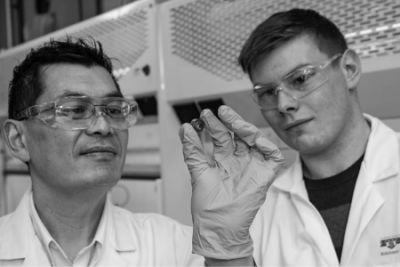The Warm Up: Room Temperature Superconductivity
4 September, 2023

Dr Shen Chong and Research Assistant Fergus Robinson examining a freshly prepared iron-based composite sample.
It’s arguably the ‘holy grail’ of solid-state physics - superconductors that operate at or near room temperature.
“It’s definitely the dream,” says Dr Shen Chong, Associate Investigator at the MacDiarmid Institute and Senior Scientist at the Robinson Research Institute.
“And whoever cracks it will surely get the Nobel Prize.”
Superconductors were first discovered by another Nobel winner, Dutch physicist Kamerlingh Onnes. In 1911 he cooled elemental mercury to very low temperatures and observed that the electrical resistance disappeared. That was at a frosty 4 °Kelvin (-269 °C). Since then, low temperature superconductors, super-chilled with liquid helium, have come to be used to generate high-intensity magnetic fields for magnetic resonance imaging (MRI) scanners in hospitals, experimental nuclear fusion reactors and even the Large Hadron Collider.
We’re working towards the superconductors we'll need for high-intensity magnetic fields applications.
Dr Shen Chong Associate Investigator Robinson Research Institute
High-temperature superconductors followed, allowing the temperature to rise to a relatively balmy 77 °K (−196.2 °C) the boiling point of the liquid nitrogen (LN2) that keeps them cool. High-temperature superconductors increasingly show promise for real-world uses such as in motors and generators, power storage systems and even electricity lines.
In the labs at the Robinson Research Institute, scientists have developed and (with the company HTS-110 Ltd) commercialised a system for determining the characteristics of superconducting wires.
“What I'm trying to do is pursue new types of superconductors, understand how they work, and optimise their physical properties to make them cheaper.”
Yet in doing so, Dr Chong grapples every day with a troubling trade-off.
Iron as an alternative
With liquid helium selling for around $60 a litre and in increasingly short supply and materials in high-temperature superconductors too delicate for many applications, the effort to discover new superconductors that can operate at higher temperatures is intensifying. One path Dr Chong is exploring first opened up in 2008, when iron-based materials were discovered to have superconductivity in ways that could give them advantages over conventional copper-oxide superconductors.
“We are looking at ways to modify iron-based superconductors so that they can carry higher electrical currents.” says Dr Chong.
“Ultimately, it is about trying to increase the maximum magnetic field for superconducting magnets while ensuring that the cost is competitive."
The applications of superconductors that most appeals to him are their use in medical imaging equipment that can ultimately help save lives.
“The magnetic field in MRI machines is adequate at the moment, but to get the resolution you need to really look at the tissue in detail and perform chemical analysis at the same time, you need a high magnetic field.” More efficient superconductors able to operate at higher temperatures could reduce the cost and improve the availability of MRI scanners and well as nuclear magnetic resonance (NMR) instruments, which allow the molecular structure of materials to be analysed.
“If we can make wires out of this iron material, it could be cheaper and more efficient than existing high-temperature superconductors,” says Dr Chong, who has been with the Robinson Research Institute for nearly seven years and in 2016 received a Marsden Fund grant to pursue his research on iron-based wires.
Sensors and storage
Dr Chong and MacDiarmid Institute Principal Investigator Professor Grant Williams are also exploring using sensors to create magnetic and temperature maps to monitor the health of our power generation and distribution infrastructure.
The pair are seeking to test fieldtest prototypes that would take advantage of the magnetochromic effect and photoluminescence to spot fluctuations in magnetic fields and temperature variations that indicate equipment failure may be imminent. The sensors may be more accurate and safer to use than existing wired magnetic sensors and will be trialed with the Robinson Research Institute’s partners in the electricity sector.
Yet another project Dr Chong is collaborating on seeks to develop luminescent materials that capture data in optical form very efficiently and could be used to reduce energy consumption in data centres for long term data storage.
Storing data in 3D would give massive improvements in storage density. We're aiming for devices that can store data for centuries without loss of data and without any electronics.”
Dr Joe Schuyt Former PhD student and a MacDiarmid Institute collaborator
The importance of resilience
Dr Chong said a highlight of his work was receiving the mentorship of Professor Jeff Tallon, a world leader in hightemperature superconductors and Emeritus Investigator at the MacDiarmid Institute.
“Jeff taught me that tiny things can make a big difference to your results,” Dr Chong says.
“He’s also shown me how to be resilient in an environment where we are constantly having to look for new funding to keep doing our research.”
For now, the search for better superconductors continues. Says Dr Chong: “The great thing about being part of the MacDiarmid Institute is the physicists, molecular chemists and crystallographers I get to work with. It is these types of collaborations that will move us towards our goal.”


